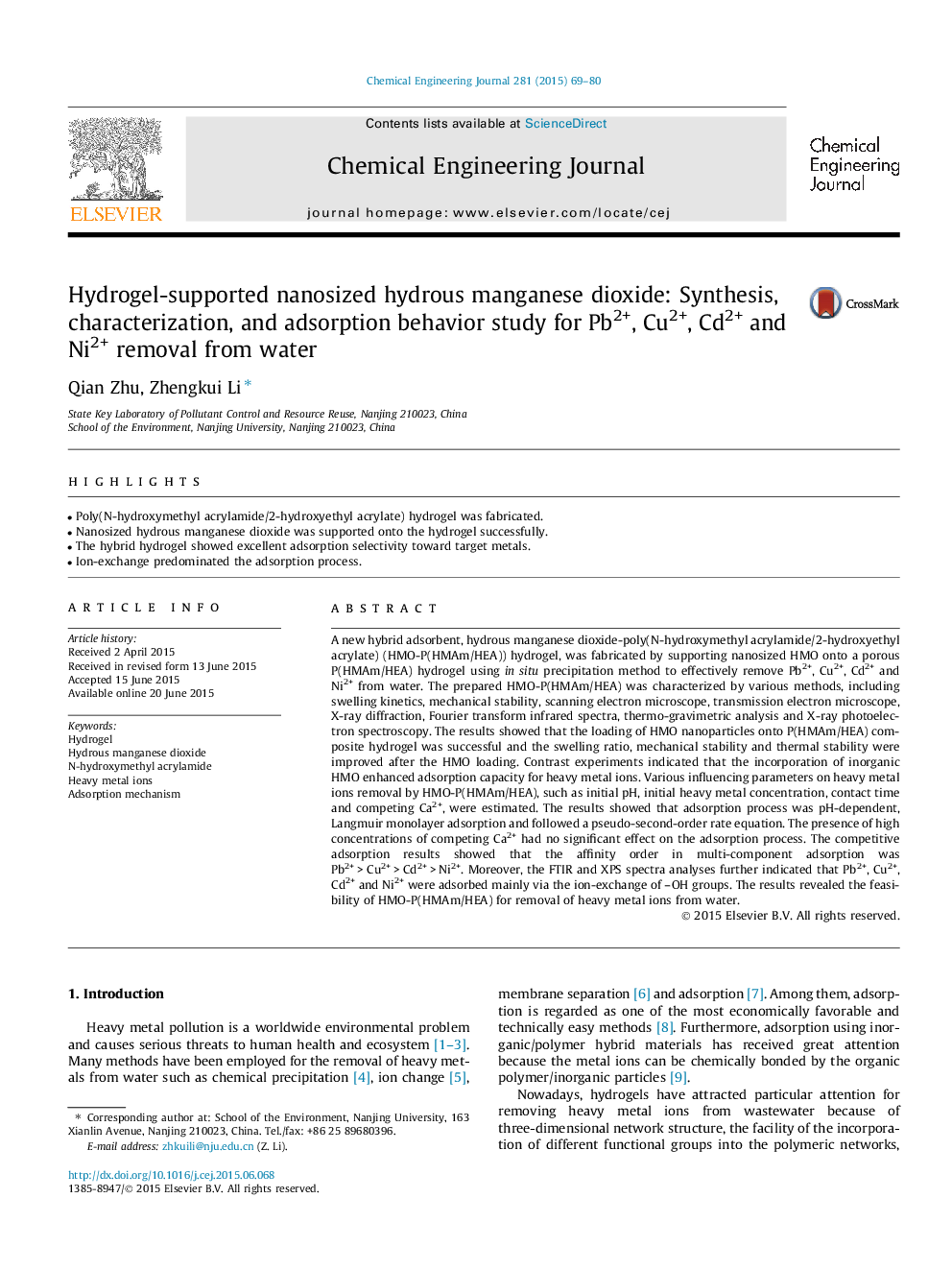| کد مقاله | کد نشریه | سال انتشار | مقاله انگلیسی | نسخه تمام متن |
|---|---|---|---|---|
| 6584019 | 456361 | 2015 | 12 صفحه PDF | دانلود رایگان |
عنوان انگلیسی مقاله ISI
Hydrogel-supported nanosized hydrous manganese dioxide: Synthesis, characterization, and adsorption behavior study for Pb2+, Cu2+, Cd2+ and Ni2+ removal from water
دانلود مقاله + سفارش ترجمه
دانلود مقاله ISI انگلیسی
رایگان برای ایرانیان
کلمات کلیدی
موضوعات مرتبط
مهندسی و علوم پایه
مهندسی شیمی
مهندسی شیمی (عمومی)
پیش نمایش صفحه اول مقاله

چکیده انگلیسی
A new hybrid adsorbent, hydrous manganese dioxide-poly(N-hydroxymethyl acrylamide/2-hydroxyethyl acrylate) (HMO-P(HMAm/HEA)) hydrogel, was fabricated by supporting nanosized HMO onto a porous P(HMAm/HEA) hydrogel using in situ precipitation method to effectively remove Pb2+, Cu2+, Cd2+ and Ni2+ from water. The prepared HMO-P(HMAm/HEA) was characterized by various methods, including swelling kinetics, mechanical stability, scanning electron microscope, transmission electron microscope, X-ray diffraction, Fourier transform infrared spectra, thermo-gravimetric analysis and X-ray photoelectron spectroscopy. The results showed that the loading of HMO nanoparticles onto P(HMAm/HEA) composite hydrogel was successful and the swelling ratio, mechanical stability and thermal stability were improved after the HMO loading. Contrast experiments indicated that the incorporation of inorganic HMO enhanced adsorption capacity for heavy metal ions. Various influencing parameters on heavy metal ions removal by HMO-P(HMAm/HEA), such as initial pH, initial heavy metal concentration, contact time and competing Ca2+, were estimated. The results showed that adsorption process was pH-dependent, Langmuir monolayer adsorption and followed a pseudo-second-order rate equation. The presence of high concentrations of competing Ca2+ had no significant effect on the adsorption process. The competitive adsorption results showed that the affinity order in multi-component adsorption was Pb2+Â >Â Cu2+Â >Â Cd2+Â >Â Ni2+. Moreover, the FTIR and XPS spectra analyses further indicated that Pb2+, Cu2+, Cd2+ and Ni2+ were adsorbed mainly via the ion-exchange of -OH groups. The results revealed the feasibility of HMO-P(HMAm/HEA) for removal of heavy metal ions from water.
ناشر
Database: Elsevier - ScienceDirect (ساینس دایرکت)
Journal: Chemical Engineering Journal - Volume 281, 1 December 2015, Pages 69-80
Journal: Chemical Engineering Journal - Volume 281, 1 December 2015, Pages 69-80
نویسندگان
Qian Zhu, Zhengkui Li,